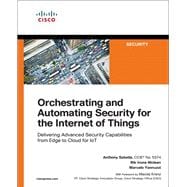Master powerful techniques and approaches for securing IoT systems of all kinds–current and emerging
Internet of Things (IoT) technology adoption is accelerating, but IoT presents complex new security challenges. Fortunately, IoT standards and standardized architectures are emerging to help technical professionals systematically harden their IoT environments. In Orchestrating and Automating Security for the Internet of Things, three Cisco experts show how to safeguard current and future IoT systems by delivering security through new NFV and SDN architectures and related IoT security standards.
The authors first review the current state of IoT networks and architectures, identifying key security risks associated with nonstandardized early deployments and showing how early adopters have attempted to respond. Next, they introduce more mature architectures built around NFV and SDN. You’ll discover why these lend themselves well to IoT and IoT security, and master advanced approaches for protecting them. Finally, the authors preview future approaches to improving IoT security and present real-world use case examples.
This is an indispensable resource for all technical and security professionals, business security and risk managers, and consultants who are responsible for systems that incorporate or utilize IoT devices, or expect to be responsible for them.
· Understand the challenges involved in securing current IoT networks and architectures
· Master IoT security fundamentals, standards, and modern best practices
· Systematically plan for IoT security
· Leverage Software-Defined Networking (SDN) and Network Function Virtualization (NFV) to harden IoT networks
· Deploy the advanced IoT platform, and use MANO to manage and orchestrate virtualized network functions
· Implement platform security services including identity, authentication, authorization, and accounting
· Detect threats and protect data in IoT environments
· Secure IoT in the context of remote access and VPNs
· Safeguard the IoT platform itself
· Explore use cases ranging from smart cities and advanced energy systems to the connected car
· Preview evolving concepts that will shape the future of IoT security








